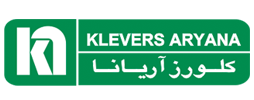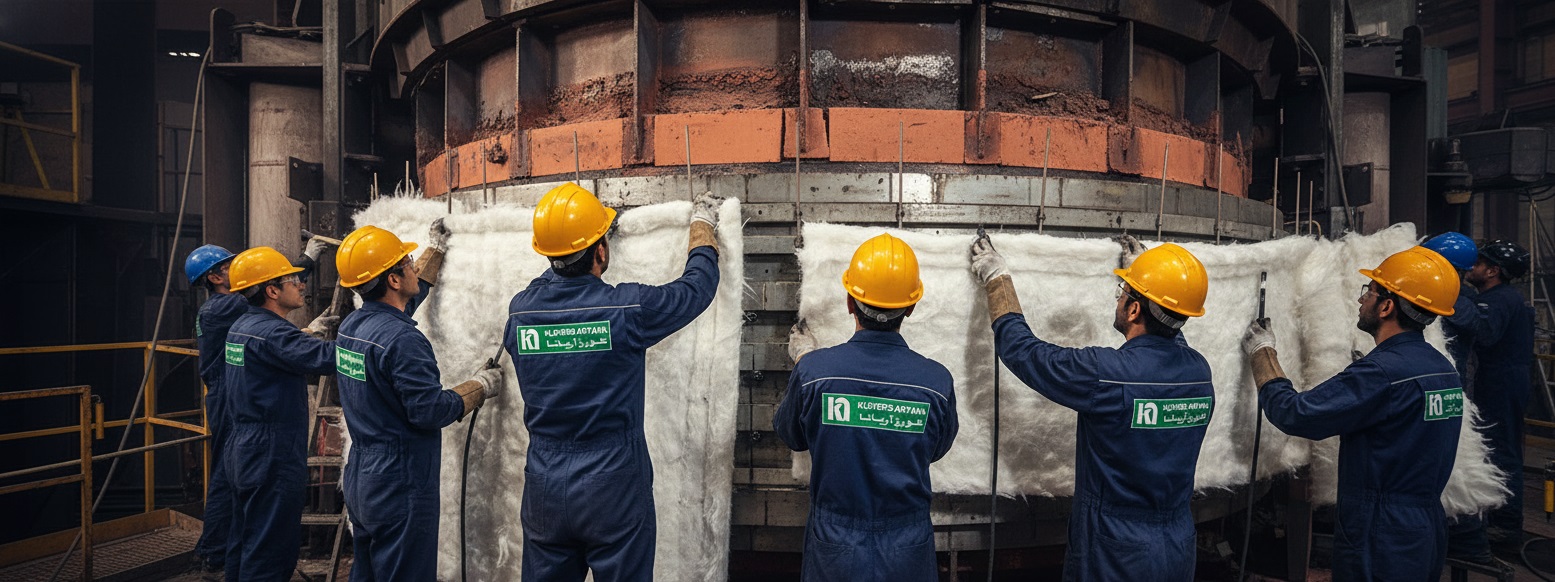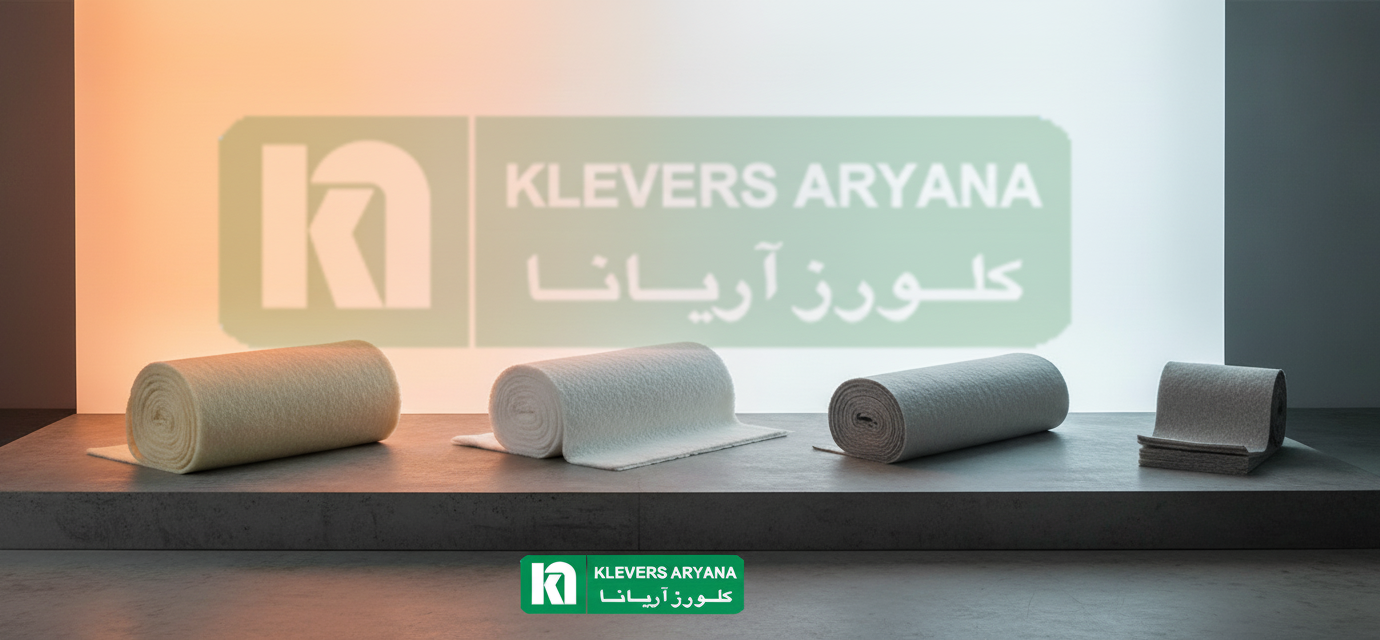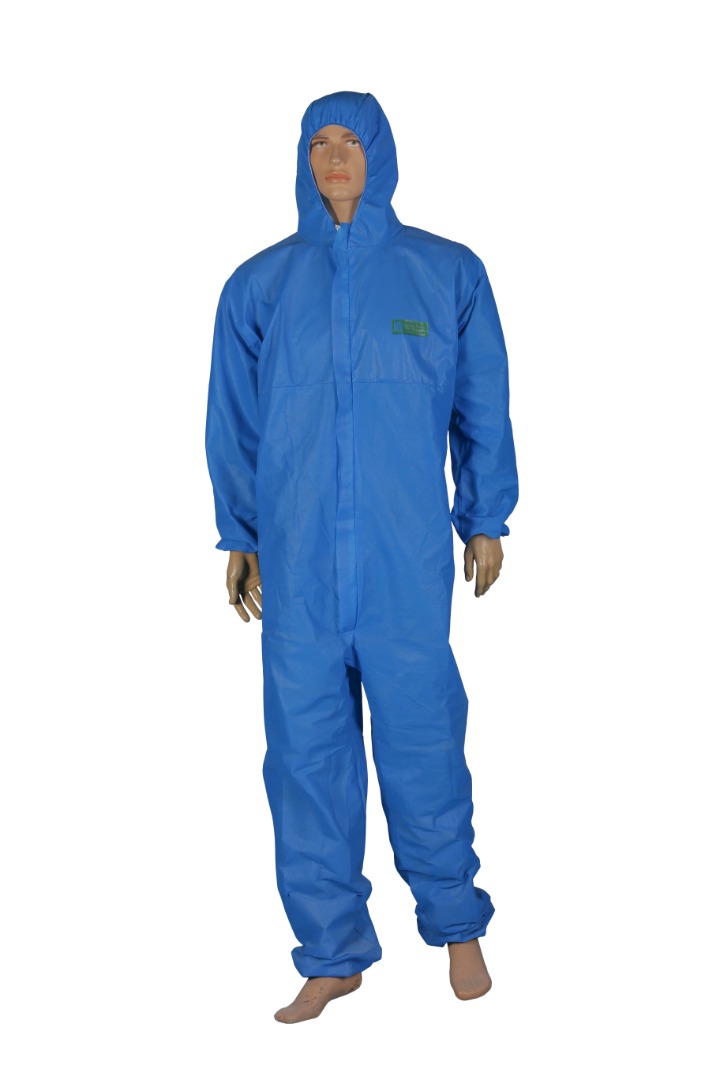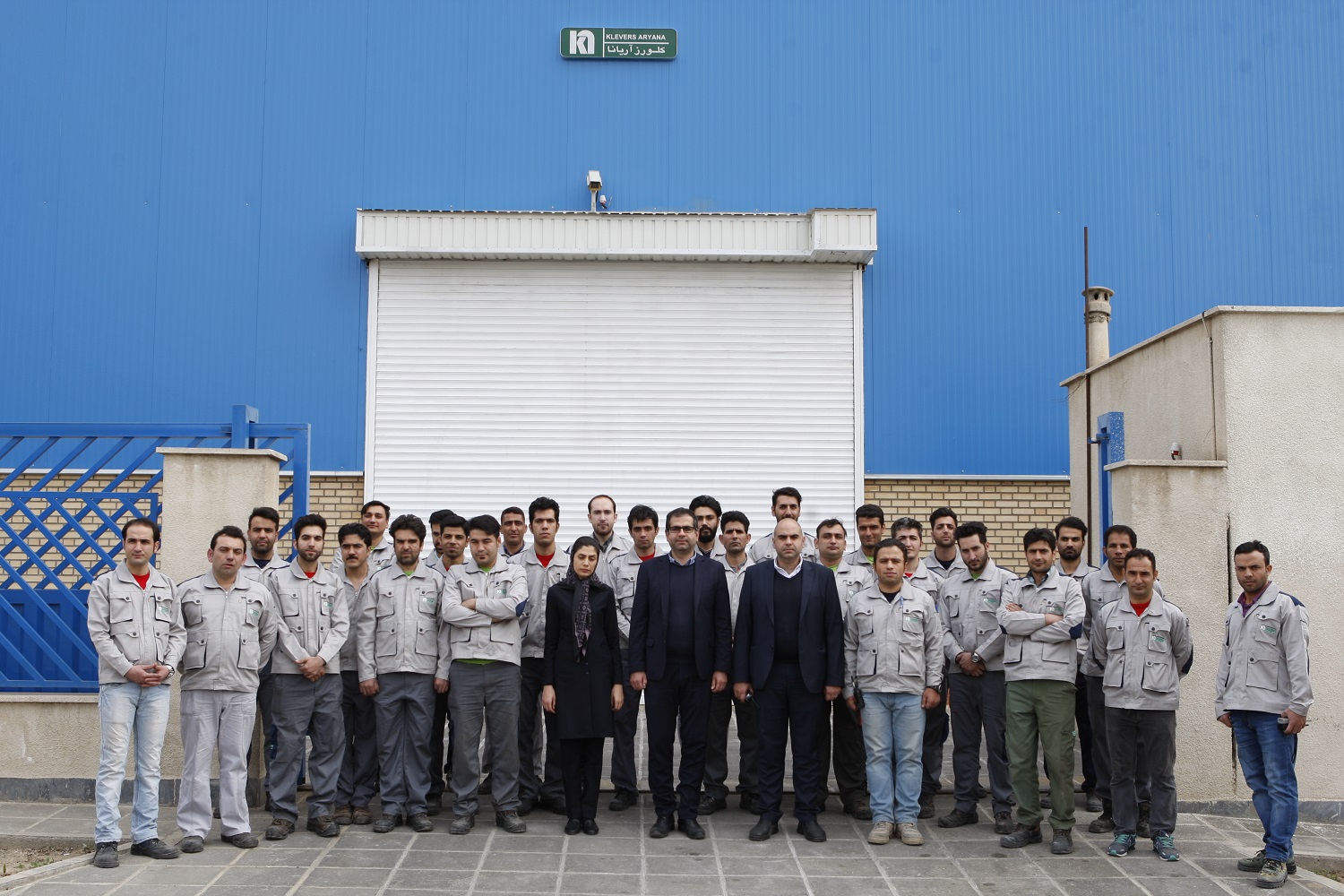The copper production industry, one of the main pillars of core industries worldwide, is known for its complex and highly energy-intensive processes. From the initial smelting of concentrate in massive furnaces to the refining and molten metal holding stages, extremely high temperatures (exceeding 1200°C) play a vital role. Under such conditions, thermal energy management is not just a competitive advantage but a strategic necessity for operational stability, reducing production costs, and ensuring safety and environmental protection. This is where the application of thermal insulation in the copper industry emerges as a specialized and key field of knowledge.
Thermal insulation in this industry is more than a simple coating to prevent heat loss. It is a multifaceted engineering approach that directly impacts metallurgical efficiency, equipment lifespan, and the quality of the final product. Without proper insulation and refractory solutions, smelting and holding furnaces, ladles, and molten metal transfer channels (launders) would suffer from severe energy loss, rapid corrosion, and unplanned shutdowns, all of which lead to substantial economic losses.
This article provides a specialized review of the role, types, and strategic benefits of thermal insulation and refractory materials in the copper production cycle, from Flash Smelting furnaces to anode furnaces and Peirce-Smith Converters. Our goal is to offer a comprehensive perspective for specialists and professionals in this field, helping to optimize processes and achieve higher productivity through a deeper understanding of this technology.

Unique Thermal Challenges in the Copper Industry
The operational environment in the copper industry presents a series of tough challenges for materials engineers and equipment designers:
- Extremely High Temperatures: Processes like smelting and refining require temperatures that would melt or degrade most engineering materials. Maintaining these temperatures in a stable and uniform manner requires minimal heat loss.
- Severe Chemical Corrosion: Molten copper and the slags produced (which can be of the fayalite or calcium ferrite type) are highly corrosive. Refractory and insulation materials must be resistant to penetration and chemical reaction with these substances.
- Mechanical Abrasion: The movement of solid charge, molten metal, and gas injection causes abrasion and erosion on the inner linings of the equipment.
- Thermal Shock (Thermal Cycling): Batch processes, such as those in converters, cause severe temperature fluctuations, imposing immense mechanical stress on the refractory lining, which can lead to cracking and premature failure.
- Safety and Environment: Heat control is crucial for protecting personnel and preventing damage to auxiliary equipment. Furthermore, optimizing energy consumption means reducing greenhouse gas emissions and moving towards more sustainable production.
To overcome these challenges, an engineered internal lining system, consisting of various refractory and insulation layers, is designed and implemented. This system must be able to simultaneously retain heat within the chamber, resist chemical and physical attack, and maintain its structural integrity throughout the furnace campaign life. A deep understanding of insulating materials is the first step in designing these complex systems.
The Dual Role of Refractories and Insulation Materials
In the copper industry, the thermal protection of equipment is handled by a combined system that includes Refractories and Insulation materials. Although both are used for heat management, they have different functions and properties.
1. Refractory Materials: The Front Line of Defense
Refractory materials are the layers in direct contact with the molten metal, slag, and hot process atmosphere. Their main task is to withstand the harsh conditions inside the furnace. These materials must have the following characteristics:
- Very High Melting Point: To remain stable at operating temperatures.
- Chemical Resistance: To prevent corrosion from molten metal and slag.
- High-Temperature Mechanical Strength: To withstand pressure and abrasion.
- Thermal Shock Resistance: To endure heating and cooling cycles.
In copper industry furnaces, different refractories are used depending on the zone and process type. For example, Magnesia-Chrome bricks are a common choice in converters and flash furnaces due to their excellent resistance to basic slags. In other areas with less chemical attack, high-purity Alumina bricks (70% to 90%) may be used. In some special applications like nozzles and injection zones, more advanced refractories such as Silicon Carbide are used for their exceptional wear resistance and thermal stability.
2. Insulation Materials: The Strategic Backup
Behind the refractory layers lie the insulation layers. These materials do not directly face the molten metal, but they play a key role in reducing heat loss from the external shell of the equipment. The main objective of insulation materials is to maximize thermal resistance (R-Value) and minimize thermal conductivity.
Key features of insulation materials include:
- Very Low Thermal Conductivity: This is the most important feature of an insulator.
- Low Density: Which reduces the total weight of the system and structural stresses.
- Adequate Thermal Resistance: Although not as high as refractories, they must be able to withstand the temperature behind the refractory layer.
In the copper industry, various types of insulation are used in the backup layers:
- Insulating Fire Bricks (IFB): These bricks have high porosity, which significantly reduces their thermal conductivity. They are used as a backup layer in the walls and roofs of furnaces.
- Ceramic Fiber Blanket: These flexible and very lightweight materials are an excellent choice for insulating irregular surfaces, doors, and as thermal seals. Refractory ceramic blankets, capable of withstanding high temperatures, play a crucial role in preventing heat loss.
- Mineral Wool (Rock Wool and Slag Wool): For lower temperature applications, such as insulating the external body of the furnace and gas ducts, mineral wool is used as an economical and effective solution.
- Insulating Castables: These materials are cast monolithically and are used for insulating backup layers in floors and walls.
An intelligent design employs an optimal combination of these two material categories. The thick refractory layer provides chemical and mechanical resistance, while the insulation layer keeps the external shell temperature low by preventing heat escape. This not only results in massive savings in fuel or electricity consumption but also ensures personnel safety and prevents damage to the furnace’s steel structure.
Specific Insulation Applications in Key Copper Production Equipment
Each of the main pieces of equipment in the copper production line, from smelting to casting, has unique operating conditions and insulation requirements. Below, we delve into a specialized examination of insulation applications in this equipment.
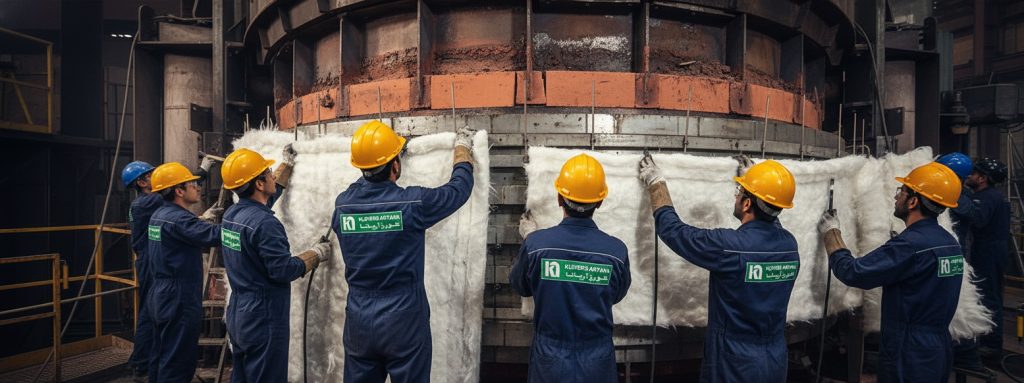
1. Smelting Furnaces
Smelting furnaces are the beating heart of a copper plant. There are various types, the most common being the Flash Smelting Furnace and the Ausmelt/Isasmelt furnace.
- Flash Smelting Furnace: In these furnaces, dry copper concentrate is injected with oxygen or oxygen-enriched air into a hot chamber. Rapid exothermic reactions raise the temperature sharply.
- Insulation: The walls and roof of these furnaces are designed with a multi-layer system. The working lining in contact with the melt is usually made of high-quality magnesia-chrome bricks. Behind this layer, one or two layers of Insulating Fire Bricks (IFB) are placed, followed by ceramic boards or ceramic blankets. This composite structure creates a steep temperature gradient; the internal temperature might be 1400°C, while the external steel shell temperature drops below 200°C.
- Ausmelt/Isasmelt Furnace (Top-Submerged Lance – TSL): These furnaces use a lance to inject fuel and air from the top into the molten bath. The intense turbulence of the melt creates high mechanical wear.
- Insulation: In addition to refractory-insulation systems similar to flash furnaces, water-cooling systems are also used in the walls. Effective insulation behind these cooling panels prevents excessive energy loss to the cooling water system and helps form a protective layer of frozen slag (Freeze Lining), which itself acts as a refractory layer.
2. Peirce-Smith Converter
The copper matte produced in the smelting furnace is transferred to the P-S converter to remove remaining sulfur and iron. In this horizontal cylindrical converter, air is blown through nozzles (tuyeres) into the molten bath. This process is accompanied by severe thermal cycles and splashing of the melt.
- Insulation: The tuyere line is the most critical area due to the injection of cold air and intense reactions, and it is usually lined with highly resistant magnesia-chrome bricks. The main body of the converter is also lined with the same type of brick. However, thermal insulation is crucial for maintaining the melt temperature between blowing cycles. Using a backup layer of insulating refractory castables or lightweight bricks helps reduce temperature drop during standby times and lowers the fuel consumption for reheating.
3. Anode Furnaces
The blister copper from the converter is transferred to anode furnaces to remove residual oxygen and sulfur. This process is carried out at relatively lower temperatures (around 1150-1250°C), but the final product quality is highly dependent on temperature stability.
- Insulation: Here, the main goal of insulation is precise temperature control and reducing energy costs. Using advanced insulation systems like ceramic fiber modules in the roof and upper walls (not in contact with the melt) can drastically reduce heat loss. You can visit this page to learn about different types of refractory and high-temperature insulation. The layers in contact with the melt are lined with high-quality alumina-chrome or magnesia-chrome bricks, backed by insulation layers.
4. Metal Transfer Systems
- Ladles: Ladles are used to transfer matte, slag, and molten copper between different units. Proper ladle insulation is vital to prevent temperature loss of the melt during transfer. This reduces the need for superheating the melt in the source furnace and helps extend the life of the ladle’s refractory lining. Typically, a layer of Refractory Castable is used as the main lining, with a backup layer of insulating concrete or ceramic blanket.
- Launders: These channels transfer molten metal from the furnace to the casting section. Complete insulation of these launders using pre-fabricated parts made of Calcium Silicate or ceramic fiber prevents the melt from freezing or experiencing severe temperature drops.
Strategic Advantages of Investing in Thermal Insulation
Implementing an engineered thermal insulation system in the copper industry is more than a technical requirement; it is a smart investment with high returns in several key areas. The benefits derived from this approach have a direct impact on profitability, sustainability, and operational safety.
1. Optimizing Energy Consumption and Reducing Costs
The most significant and tangible benefit of insulation is the dramatic reduction in energy consumption. Metallurgical furnaces are massive consumers of fossil fuels or electrical energy.
- Reduced Heat Loss: An efficient insulation system acts as a powerful barrier, preventing heat from escaping through the walls, roof, and floor of the equipment. This means less energy input is required to maintain the operating temperature. Studies have shown that proper insulation can reduce heat loss by up to 90% compared to uninsulated systems. This saving translates directly into lower fuel (gas, oil) or electricity costs, which constitute a significant portion of the production costs (OPEX).
- Process Stability: By minimizing temperature fluctuations, process control becomes more precise, and the quality of the final product (such as copper purity) improves. This stability reduces the need for reheating or frequent adjustments, increasing overall efficiency.
2. Increasing Equipment Lifespan
Refractories and insulation act as a thermal and chemical shield, protecting the expensive steel shell of the furnace.
- Reduced Thermal Stresses: By keeping the external shell temperature low, deformation, creep, and thermal fatigue of the steel structure are prevented. This significantly increases the mechanical lifespan of the furnace.
- Protection of Refractory Lining: A suitable insulation layer behind the refractory layer reduces the thermal gradient across the lining. This helps to lower internal stresses in the bricks, preventing them from cracking and premature wear. As a result, the interval between major repairs is extended, and the furnace “campaign” or service life is prolonged. This means fewer production stoppages and lower costs associated with lining demolition and reconstruction.
3. Improving Safety and Working Conditions
The high surface temperature of hot equipment poses a serious risk to personnel working nearby.
- Reduced Surface Temperature: Effective insulation lowers the external shell temperature of furnaces, ladles, and other equipment to safe levels (typically below 60-70°C). This minimizes the risk of burns and accidents from accidental contact.
- Lower Ambient Temperature: By reducing heat radiation from equipment surfaces, the ambient air temperature in the workshop also decreases. This makes working conditions more tolerable for operators and increases workforce productivity.
4. Environmental Considerations and Sustainable Production
In today’s world, reducing the carbon footprint is a global priority.
- Reduced Greenhouse Gas Emissions: Optimizing energy consumption directly means burning less fuel and, consequently, reducing CO2 and other pollutant emissions. This helps companies meet their environmental targets and avoid potential penalties.
- Moving Towards Green Industry: Investing in advanced insulation technologies demonstrates a company’s commitment to sustainable and responsible production, which can enhance its brand image and reputation both nationally and internationally.
A deep understanding of the difference between rock wool and ceramic wool and choosing the right material for each application is one of the keys to achieving these strategic benefits.
Conclusion and the Future of the Industry
As discussed in this article, the application of thermal insulation in the copper industry is a specialized and vital field that directly impacts all aspects of production, from energy efficiency and costs to safety and environmental sustainability. The intelligent and engineered selection of refractory and insulation systems is no longer an option but a necessity for survival and competition in the global copper market.
With advancing technology, newer insulation materials with lower thermal conductivity, higher temperature resistance, and easier installation are being developed. Materials like nanostructured insulations and aerogels, although not yet widely used in the copper industry, have the potential to revolutionize energy efficiency in the future. Additionally, the use of computer simulations to model heat transfer in furnaces allows engineers to optimize the design of insulation systems before construction and to achieve the best combination of materials for each specific application.
Introducing Klevers Aryana Company
With over two decades of experience in supplying and providing innovative thermal insulation and refractory solutions, Klevers Aryana Company is proud to operate as a reliable partner alongside the country’s core industries, including the strategic copper industry. With a deep understanding of the technical and operational challenges of this industry, we offer a wide range of high-quality products designed to meet the most demanding conditions.
Our engineering and sales team is ready to provide expert advice to help you select the most optimal and cost-effective insulation solutions to achieve your production goals and reduce energy costs.
For more information and to receive a free technical consultation, please visit our Contact Us page.
References
- Copper Smelting Furnace Construction and Refractories Used. (2021, January 13). 911Metallurgist.
- Refractory solutions for copper. (2024, December 3). HWI.
- Durable Copper Furnace Protection Built to Perform. Saint-Gobain Performance Ceramics & Refractories.
- Refractory Materials for Copper and Nickel Smelting. (2025, April 17). Rongsheng Refractory.
- Copper and Nickel Refractory Products. Resco Products.
- How Does Black PE Insulated Copper Pipe Improve Energy Efficiency? (2025, October 19).
- How Insulation Materials Improve Energy Efficiency. (2024, November 11).
- The benefits of thermal insulation. (2023, December 22). Sunparadise.
- What is thermal insulation and why is it crucial for your project?. STAC.
